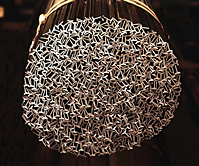| Items |

6061-T6-1500-1500-250
Aluminum Structural Tees - Series 6061
|

6061-T6-2000-2000-250
Aluminum Structural Tees - Series 6061
|
|
Material
|
N/A
Aluminum
|
|
Shapeform
|
N/A
Structural Tees
|
|
Series
|
N/A
6061-T6
|
|
Grade
|
N/A
6061
|
|
Temper
|
N/A
T6
|
|
Size
|
N/A
1 1/2 x 1 1/2 x 1/4 inches
|
N/A
2 x 2 x 1/4 inches
|
|
Working Decimal Equivalent
|
N/A
1.500 x 1.500 x 0.250 inches38.1 x 38.1 x 6.35 mm
|
N/A
2.000 x 2.000 x 0.250 inches50.8 x 50.8 x 6.35 mm
|
|
Dimension A
|
N/A
1 1/2 inches
|
N/A
2 inches
|
|
Dimension B
|
N/A
1 1/2 inches
|
N/A
2 inches
|
|
Thickness
|
N/A
1/4 inches
|
|
Estimated Weight
|
N/A
0.869 lbs/ft1.293214516 kg/m
|
N/A
1.259 lbs/ft1.873598476 kg/m
|
|
Estimated Weight per 25' Bar
|
N/A
21.725 lbs9.841425 kg
|
N/A
31.475 lbs14.258175 kg
|
|
ASTM Specification
|
N/A
AMS-QQ-A-200/16 AMS-QQ-A-200/8
|
|
Stock Length
|
N/A
25 ft
|
|
Flanges
|
N/A
Tapered
|
|
Ultimate Strength
|
N/A
45 ksi
|
|
Yield Strength
|
N/A
40 ksi
|
|
Elongation percent in 2 inches
|
N/A
12
|
|
Hardness Brinnel Number
|
N/A
95
|
|
Ultimate Shearing Strength
|
N/A
30 ksi
|
|
Fatigue Endurance Limit1
|
N/A
14 ksi
|
|
Modulus of Elasticity2
|
N/A
10.0 x 103 ksi
|
|
Resistance to Corrosion - General3
|
N/A
B
|
|
Stress Corrosion Cracking4
|
N/A
A
|
|
Workability (Cold)5
|
N/A
C
|
|
Mechinability
|
N/A
C
|
|
Brazeability6
|
N/A
A
|
|
Gas Weldability7
|
N/A
A
|
|
Arc Weldability8
|
N/A
A
|
|
Resistance Spot and Seam Weldability9
|
N/A
A
|
|
Applications
|
N/A
Heavy-duty structures requiring good corrosion resistance, truck and marine, railroad cars, furniture, pipelines
|
|
Density
|
N/A
0.098 lbs/in³
|
|
Specific Gravity
|
N/A
2.70
|

